I asked former Alliance member Hadding Scott to set up a site where these articles from not only NV magazine, launched in 1978, but also its earlier versions NV tabloid newspaper and its forerunner, Attack! tabloid from the early 1970s. It took another three years or so before I was able to be appointed to the chairmanship of the failing National Alliance by its board of directors to restore and try to put it back on the Piercean path, but in the meantime I and a few volunteers had preserved and distributed scores of Dr. Pierce's earlier writings, still archived at the site linked at bottom.
It's time this excellent article about the Life Rune, written by NA member Jim Dewitt in 1985, is featured on WhiteBiocentrism.com that I and Kevin Strom launched in 2013 as part of our efforts to restore the National Alliance
Friday, January 13, 2012
The History & Significance of the Life Rune
by Jim Dewitt
From National Vanguard magazine, Issue No. 105, May-June 1985
Printed on the inside cover of each NATIONAL VANGUARD is the statement: The symbol which appears in the NATIONAL VANGUARD logotype is the Life Rune. It comes from an ancient alphabet, or futhark, used in northern Europe for many centuries before the general adoption of the Roman alphabet there. The Life Rune signifies life, creation, birth, rebirth, and renewal. It expresses in a single symbol the raison d'etre of the National Alliance.
Like the cross and various sun signs, the symbol is an ancient one. Over 3,000 years ago the Germanic peoples of northern Europe carved it on rocks, along with other pre-runic figures, perhaps as a sign of a man with arms reaching upward and addressing the gods.
Later -- something between 2,000 and 1,800 years ago -- the Germanic peoples began using a script having 24 characters, with both phonetic and magical-symbolic values, called runes. These were organized in a system known as the "futhark." The name "futhark" derives from the initial sounds of the names of the first six runes, that is: feo - ur - thurs - asa - rit - kaan. This is similar to the way in which the word "alphabet" comes from the names of the first two Greek letters, alpha and beta.
In addition to the original Germanic futhark, there were two principle later runic systems: the expanded Anglo-Saxon, with up to 33 runes; and the reduced Norse, with 16 runes. Although many runes are common to the various futharks, the names and phonetic values of a given rune are not always the same. Most runic characters were made up of straight vertical and diagonal strokes to facilitate their carving on wood stone, and metal.
Over 5,000 runic inscriptions have been preserved. Although these were scattered by Norse rovers from Greenland to Greece, the vast majority of them are found in Sweden. Many of these are carved on commemorative monuments, or rune stones.

The more efficient Roman alphabet eventually supplanted the futhark for most purposes throughout northern Europe, but runes continued to be used in a few places -- especially in Scandinavia -- as late as the 17th century.
The origin of runes and the futhark is as murky as the water in the depths of today's polluted Rhine. The evidence is sparse, and scholars disagree in their interpretations of it.
Some authorities speculate that the futhark simply derived from German contact with Greek or North Italic writing, about 2,000 years ago. Others suggest that the futhark and the various southern European alphabets come independently from an older, common European script. Many German, Greek, Roman, and Etruscan characters did have similar forms. For example, the figure we call the Life Rune occurred in the early Greek and Etruscan alphabets, as well as in the Germanic futhark.
It even has been proposed that the futhark must have been the brainchild of one man, rather than an evolutionary development, much as the Gothic alphabet was the creation of Bishop Wulfila, and the Cyrillic alphabet was the work of St. Cyril.

Runic writing was primarily used for Germanic religious and magical purposes: for gravestone inscriptions, for dedications, and for spells and charms. These roles overshadowed its function as a utilitarian script. The word "rune" itself comes from a Germanic root meaning a secret or a mystery; it implies arcane knowledge and wisdom. Runecraft was originally a private, esoteric practice, engaged in by those considered to be magicians. (Of course, in a preliterate society anyone who could communicate by writing might be thought of as a magician.)
Each rune had a name related to the sound of the character: names like "hail," "ice," and "birch." A single rune could stand for its name-word itself, as well as for the sound associated with that word. It was thought to have magical powers that could be used to evoke, or protect against, the force contained in that name. Runes were often inscribed on weapons, tools, and rings to give them talismanic powers.
The 15th rune in the original Germanic futhark is the one with which we are especially concerned here. It appears variously with diagonal strokes pointing upward, downward, or in both directions. All these forms represented the same sound, originally "z." Rune masters wrote individual runes up or down, left or right, without distinction. Nor was there any single convention for the direction in which lines of runes were written.
The symbol we call the Life Rune was not known as such in futhark times. In the original Germanic futhark this rune was known variously as the Axe Rune and the Elk Rune. It signified defense.
Later, in the reduced Norse futhark of the Viking Age, a formal dichotomy developed. The arms-upward rune was known as the Man Rune and had an "m" sound. The arms-downward rune had the strong palatalized "r." It was called the Yew Rune or "bow made of yew wood," a symbol of death.
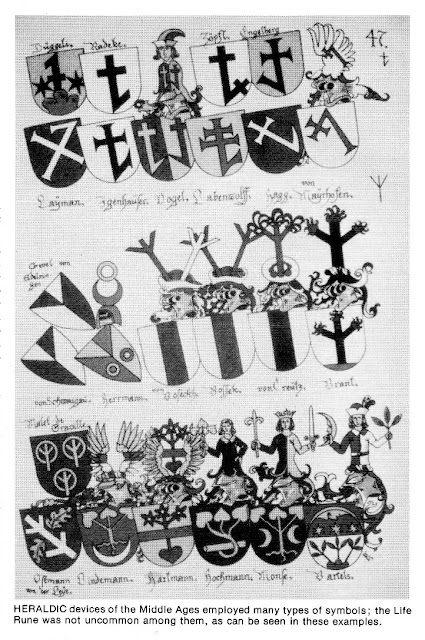
The medieval Christian church used the Axe Rune/Man Rune form as a variation of the cross. They simply bent the arms of the Latin cross upward at about a 45-degree angle to form a stylized crucifix, known as the forked cross. The shape is also suggestive of a tree. Gregory the Great, who was Pope from 590 to 604, wore a forked cross on his vestment. Fork-cross crucifixes are common in Westphalia and parts of Austria and Italy even today.
Conversely, enemies of Christianity -- Saracens, Satanists, and others -- bent the arms of the Latin cross downward to signify the crucifix broken.
Scandinavian and Anglo-Saxon Christian churchmen were, in some respects, tolerant of Germanic tradition and dabbled in the use of runes as script. However, in the 17th century Iceland people were burned as witches because runic inscriptions had been found in their possession. An official prohibition of the use of runes was thought necessary in 1639. About that time many runic monuments were destroyed in Britain.
Long after futhark times, runiform designs served as identification and decoration marks. Axe Rune/Man Rune forms were not uncommon as heraldic devices on family coats of arms.
The Romantic movement of the 19th century generated a renewed interest in things heroic, Norse, and runic that is still with us today. The designation of the Norse Man Rune as the rune of life and the Norse Yew Rune as the rune of death is principally a formulation of the late 19th/early 20th century Romantic runology of Guido von List and other German rune mystics.
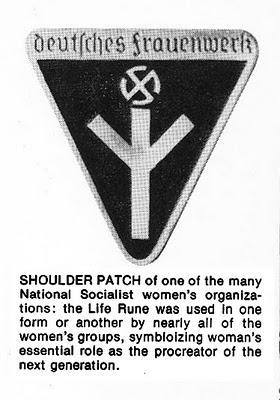
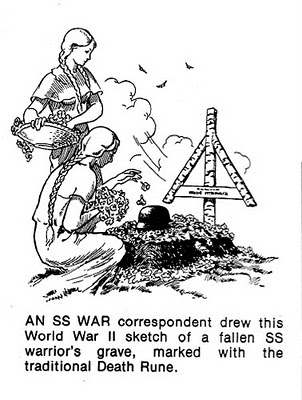
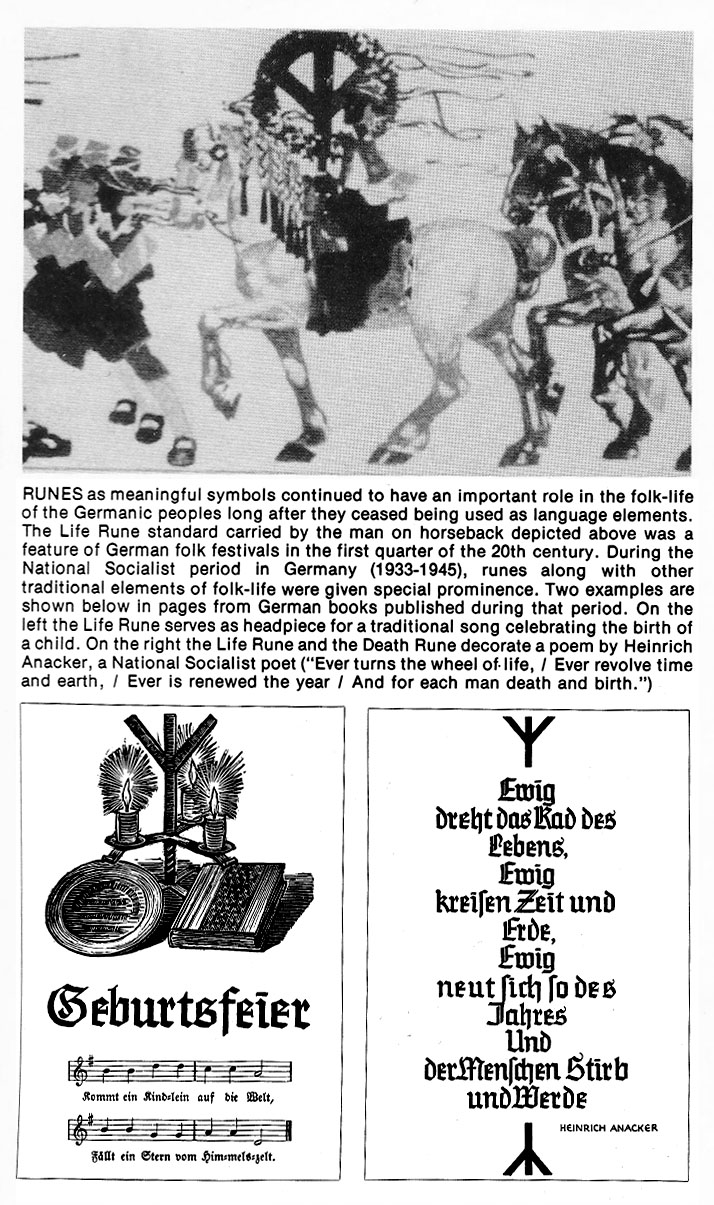
In Germany, Life and Death Runes were used in newspaper obituaries, death notices, and on gravestones: The Life Rune by the date of the person's birth and the Death Rune by the date of his passing.
The National-Socialists were inspired by the rune lore of their remote Germanic past, and they made use of the Life Rune and Death Rune in many aspects of their cultural life.
Runic emblems were also a prominent feature of National-Socialist military and civil service regalia. Among the runes used were the Tyr Rune (after the Norse god of war for whom Tuesday is named), the Sun Rune, and the Life Rune. The Life Rune was used to identify members of National-Socialist women's associations, welfare workers, and medical personnel in a number of organizations.
The designers of the emblem conceived for the nuclear disarmament movement in the late 1950's -- later known as the "peace" symbol -- were aware of the Death Rune context. They described their design as a highly stylized human being with arms only slightly raised from a downward position in an attitude of hopelessness: a gesture-of-despair motif. They knew it was of ancient origin and signified the death of man.

When asked how the Life Rune is related to the more familiar peace symbol, one can describe the relationship as one of opposites: the one is related to the other as up is related to down, as life is related to death. Like heads and tails on a coin, both are aspects of the same reality.
This, briefly, is the heritage of the Life Rune, used today as the symbol of the National Alliance, as well as of some groups in Europe.
The Life Rune is an ancient, sacred sign of our folk. It has had different aspects and meanings. Now it is up to us to give it yet a new one: to make it the emblem of White resurgence everywhere.
The Life Rune stands for man with arms uplifted. It stands for man reaching upward toward higher man. It whispers to us from the past and beckons us toward the future.
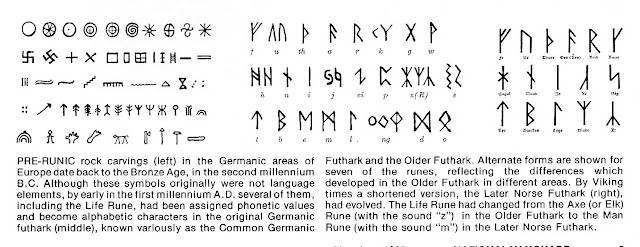
https://williamlutherpierce.blogspot.co ... ne-by.html
